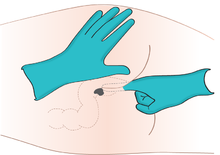Rectal administration





Rectal administration(colloquially known asboofingorplugging) uses therectumas aroute of administrationformedicationand other fluids, which areabsorbedby the rectum'sblood vessels,[Note 1]and flow into the body'scirculatory system,which distributes the drug to the body'sorgansandbodily systems.[Note 2]
A drug that is administered rectally will in general (depending on the drug) have a faster onset, higherbioavailability,shorter peak, and shorter duration thanoraladministration.[1][2]Another advantage of administering a drug rectally, is that it tends to produce lessnauseacompared to the oral route and prevents any amount of the drug from being lost due toemesis(vomiting). In addition, the rectal route bypasses around two-thirds of thefirst-pass metabolismas the rectum's venous drainage is two-thirdssystemic(middleandinferior rectal vein) and one-thirdhepatic portal system(superior rectal vein). This means the drug will reach the circulatory system with significantly less alteration and in greater concentrations.[Note 3]Finally, rectal administration can allow patients to remain in the home setting when the oral route is compromised. Unlikeintravenouslines, which usually need to be placed in aninpatientenvironment and require special formulation ofsterilemedications,[3]a specialized rectalcathetercan be placed by a clinician, such as ahospicenurse or home health nurse, in the home. Many oral forms of medications can be crushed and suspended in water to be given via a rectalcatheter.
The rectal route of administration is useful for patients with any digestive tract motility problem, such asdysphagia,ileus,orbowel obstruction,that would interfere with the progression of the medication through the tract. This often includes patientsnear the end of life(an estimated 1.65 million people are inhospicecare in the US each year).[4]Because using the rectal route enables a rapid, safe, and lower cost alternative to administration of medications,[5]it may also facilitate the care of patients inlong-term careorpalliative care,or as an alternative tointravenousorsubcutaneousmedication delivery in other instances.
Methods
[edit]Rectal administration of medication may be performed with any of the following:
- Asuppository,a soliddrugdelivery system inserted into the rectum, where it dissolves or melts to exert local or systemic effects.
- Amicro-enema,a small amount (usually less than 10 millilitres) of aliquid-drugsolutioninjected into the rectum.
- Alarge volume enema[6]to injectliquidinto thecoloneither to cleanse feces from as much of the colon as possible[7]or to deliver a drugsolution.
- A specializedcatheterdesigned for rectal administration of medications and liquids, that can be placed safely and remain comfortably in the rectum for repeated use.
See also
[edit]Notes
[edit]- ^The rectum has numerous blood vessels available to absorb drugs: upwards2/3rdsof the dose bypassesfirst-pass metabolismthrough systemic distribution and the rest is taken through the liver and metabolized via the hepatic portal system.
- ^The organs and systems include, depending on if the drug is able to pass theblood–brain barrier(BBB) or not, thecentral nervous system(CNS),peripheral nervous system(PNS),cardiovascular system(CVS), et cetera.
- ^Other ROAs that bypass first-pass metabolism includeinhalation(smoking,vaporizing,etc.),intravenous injection(IV),insufflation( "snorting" ), et cetera, but theoralroute does not bypass first-pass metabolism.
References
[edit]- ^De Boer AG, Moolenaar F, de Leede LG, Breimer DD. (1982) "Rectal drug administration: clinical pharmacokinetic considerations."Clin Pharmacokinetics.7(4):285–311
- ^Moolenaar F, Koning B, Huizinga T. (1979) "Biopharmaceutics of rectal administration of drugs in man. Absorption rate and bioavailability of phenobarbital and its sodium salt from rectal dosage forms." International Journal of Pharmacaceutics, 4:99–109
- ^Plumer AL. 2007.Plumer's Principles and Practices of Intravenous Therapy.Lippincott Williams & Wilkins. 753 pp.
- ^"National Hospice and Palliative Care Organization's Facts and Figures: Hospice Care in America, 2013 Edition" (PDF)Archived2014-05-13 at theWayback Machine
- ^A Quality Improvement Study: Use of a Rectal Medication Administration Device Intervention to manage end-stage symptoms in hospice patients when the oral route fails. Poster Presentations. 6th Annual Hospice Palliative Nurses Association Clinical Practice Forum, Pittsburgh, PA, September 15-15, 2012
- ^"high enema".Medical Dictionary.Merriam-Webster.Retrieved2021-04-18.
- ^Rhodora Cruz."Types of Enemas".Fundamentals of Nursing Practice.Professional Education, Testing and Certification Organization International.Retrieved2021-04-18.






